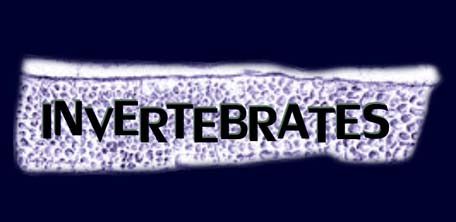
Very simply they are animals that do not develop a vertebrate column. In other words animals without backbones or spinal columns are called invertebrates. The term invertebrate represents a wide range of marine and land based animals in the world ranging from single cell protozoa up to the more commonly known insects and crustaceans (like moths and crabs) and including animals such as jellyfish and slugs. They make up around 95% of the animal world. This group includes multi-cellular organisms and mostly form a colony of individual cell that function as one. They have no cell walls and many have tissues; an exception to this is the sponge. Most of the invertebrates can move, and yet again the adult sponges remain an exception. You can slice line down one of these animals and you’d find that one side is the mirror image of the other; of course your line has to be straight – this is called symmetrical organization and many invertebrates follow it. Invertebrates reproduce sexually and are heterotrophs i.e. they feed on plants and animals.
The different types of invertebrates are:
Phylum Porifera – Sponges
Phylum Cnidaria - Jellyfish, hydras, sea anemones, corals
Phylum Echinodermata – Echinoderms
Phylum Platyhelminthes – Flatworms
Phylum Mollusca – Molluscs
Phylum Arthropoda – Arthropods
Phylum Annelida - Segmented worms like earthworm
Phylum Ctenophora - Comb jellies
We’ve already established that invertebrates are spineless creatures; and while some of them float around where the water currents take them, some remain in one place all their lives, yet others crawl around the place on numerous legs. So, how do they defend themselves? Well. some invertebrates have a hard outer case called the exoskeleton. This exoskeleton, in most cases, is hard enough to protect them from predators and external force and keeps them from drying out. The invertebrates without the exoskeleton make use of other techniques. An example of this could be the jellyfish. Drifting around apparently aimless, this Cnidaria will sting the moment you get too close and it perceives danger. The sting in some cases may even be fatal. The invertebrates with legs will use them to flee. A grasshopper or fleas will leap to safety, butterflies and other winged insects will merely fly away, while a cockroach will just make a run for it and search for cover. Some little fellows like the click beetles with legs that are unable to carry it away fast enough from the perceived danger will merely just play dead. Bright colours are another defence mechanism. Some invertebrates flash a bright colour that says “Leave me alone! I taste bad” “don’t get to close or I’ll sting you” or “Go away! I’m poisonous” (sometimes even if they’re not).
Sponges are multi-cellular animals and have a porous body and channels so water can circulate. These are the nice guys who finished last and represent the least evolved group of the animal kingdom – they are the sponges! (Now you know why SpongeBob’s a little dim-witted).
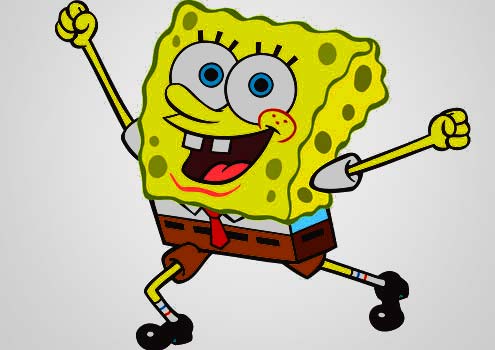
They include:
-
Glass Sponges are basket or cup shaped and pale in colour. Their spicules (small, hard bodies that serve as a skeleton) are composed of silica.
-
Demosponges which account for more than 90% of all living sponges are vibrantly coloured and can grow to be the largest of all sponges. Their spicules are made of silica. These include your trusty bath sponge.
-
Calcareous Sponges differ from the other two in that their skeletal spicules are composed of calcium carbonate. They have a rough texture, are only a few inches high and are generally dull in appearance. Sponges occur in rivers and streams from the rock pools to deep ocean floors and arctic seas to warm tropical marine seas where they are at their most stunning. They live in pineapples and have pet snails (no they don’t we were just checking if you’re still with us). They are 600 million years old and there are about 10,000 known species alive today.
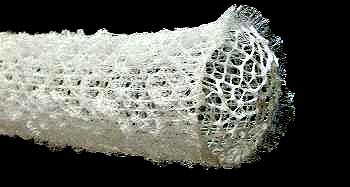
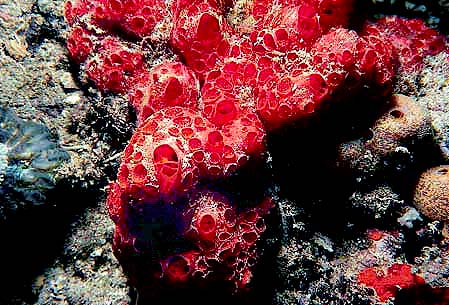
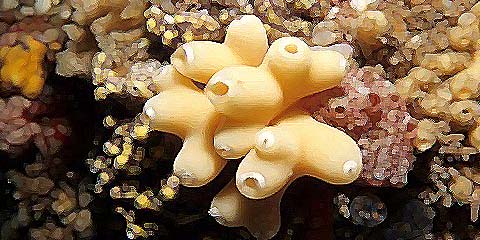
Most sponges inhabit marine environments but a few species live in freshwater habitats.
They are primitive multi-cellular animals that drive a unidirectional current of water through their body.
They are filter feeders and reproduce sexually or asexually.
Adult sponges are sessile animals i.e. attached by the base and live attached to hard rocky surfaces, shells, or submerged objects. The larvae are free-swimming creatures (planktonic).
They have no digestive, circulatory or nervous system.
They do not have organs and their cells are not organized into well-defined tissues.
Neither do they have a fixed symmetry.
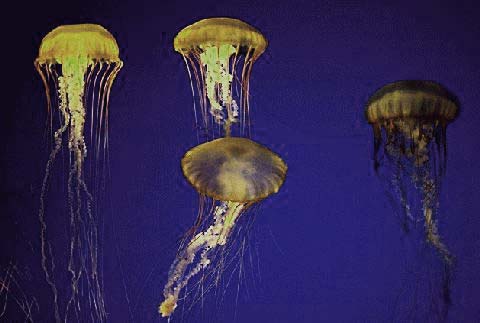
This is a group of invertebrates that includes your common jellyfish, hydras, corals, sea anemones, sea pens, sea pansies, sea wasps and tiny freshwater hydras. This group has some 11,000 species to it that can be found exclusively in aquatic, mostly marine, environments. Their basic form is quite simple consisting of a single cavity for both digestion and circulation and a single opening through which food is ingested and waste is released. Bulimic girls must definitely know what this feels like. The members of this class are radically symmetrical with tentacles that encircle their mouth.
They are found in aquatic environments mostly marine
Their bodies are multi-cellular, with few tissues and some organs.
The body contains a single cavity and opening (mouth) for food intake and excretion.
Reproduction is sexual or asexual.
The larva stage is planktonic.
They are carnivorous and feed on small crustaceans or otherwise filter feeders.
Nervous system is simple and net-like.
They are radically symmetrical.
Their skeletons are made up of calcium carbonate or chiton and are minimal.
There are two forms –
Medusa, with the best example being the jelly fish, is a free swimming structure shaped like an umbrella (called a bell) with a gastro vascular cavity that has a fringe of tentacles that hang from the edge of the bell and a mouth opening on the underside of the bell.
Polyp, in contrast is a sessile attached to the sea floor. It’s in the form of a cylindrical body stalk inside of which is the gastro vascular cavity and consists of a basal disk that attaches to a substrate, a mouth opening located on the top of the polyp, and numerous tentacles which radiate out from around the edge of the mouth opening.
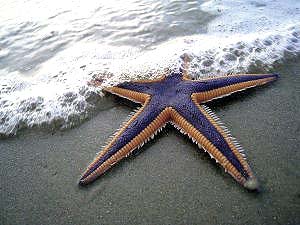
Ok before you go bonkers just reading the name we advise you take a deep breath. The meaning of this tongue-twister is derived from the Greeks word “echinóderma” meaning “spiny skin” and includes starfish, sea urchins, brittle stars, sea daisies, sand dollars, sea cucumbers and many more. They are easily identified by their radical symmetry, vascular system and internal skeleton. There are about 6000 species of echinoderms alive today. They are simple animals, lacking a brain and complex sensing organ. Echinoderms are bottom dwelling; free moving creatures evolved from sessile ancestors and have a variety of feeding habits ranging for filter-feeding to scavenging and predation. Their diet includes fine particles in the water, detritus or other animals. They posses no excretory organs and have a poorly defined open circulatory system. They sport a 5-rayed symmetry, mostly radial, sometimes bilateral and are equipped with more than two cell layers, tissues and organs. Reproduction is normally sexual.
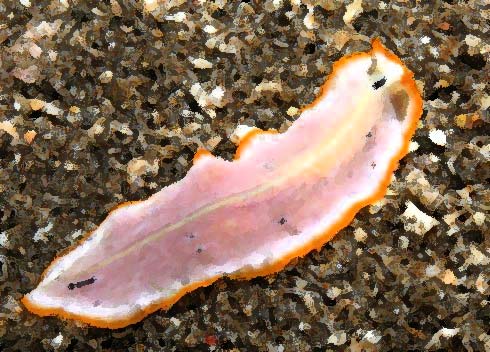
No, this is not a piece of bacon that happened to fall upon and got uploaded to get your attention. It’s an example of a Platyhelminthes. Commonly known as flatworms this class contains about 20,000 species of soft-bodied, bilaterally symmetrical, invertebrate animals. The structure of the flatworms marks a major step in animal evolution. These invertebrates have three layers of tissues with organs and organelles and no internal cavity. It has a mouth but no anus and the nervous system consists of longitudinal fibres rather than a net. Many of them are parasitic in nature and survive in all major habitats feeding on animals and other smaller life forms.
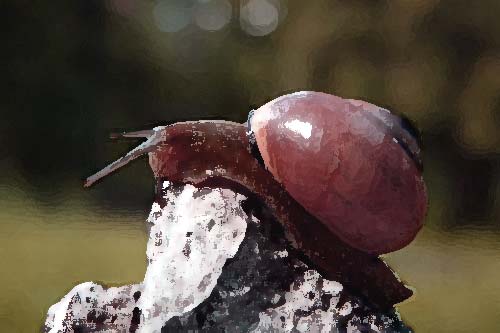
This class includes snails, slugs, chitons, squids, clams, oysters, limpets’, octopus and cuttlefish. There exist at the very least 50,000 living species today, and scientists are still counting. This makes them the second largest phylum of animals after the arthropods (we’re getting to that). Molluscs are characterised by soft bodies that have a “head” and a “foot” area. Many species also have a hard exoskeleton or protective shell made of chitin, proteins and calcium carbonate as in the shells of snails and clams or the plates of chitons. It’s difficult to generalize using a single representative species anatomical structure as these organisms are so varied in form. Hence the hypothetical “mollusc” has features like a mantle, shell, foot and visceral mass that are common to many species.
Their bodies are bilaterally symmetrical (i.e. the left and right side are mirror images) with no cavities
They have more than two cell layers, tissues and organs
The body possesses a through gut with mouth and anus
They have an open circulatory system with a heart and a pair of kidneys
Reproduction is normally sexual
Most molluscs are herbivorous, grazing on algae some feed on microscopic, filamentous algae, often using their radula as a 'rake' to comb up filaments from the sea floor. Others feed on macroscopic 'plants' such as kelp by ‘sitting’ on them, rasping the plant surface with its radula.
They are able to adapt to most environments
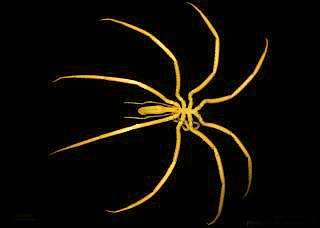
Arthropods are invertebrates having jointed limbs and a segmented body with an exoskeleton made of chitin. This group is made to accommodate over 1 million species today, with the most diverse group being, by far, the insects and including crustaceans, arachnids, sea spiders, scorpions, horseshoe crabs and a number of lesser-known groups. They make up the most species-rich group of animals and cover over three quarters of all known living and fossil organisms. They evolved more than 500 million years ago and are thriving. Arthropods mainly live on land, but aquatic species are pretty well known too. The members of this class feed on anything.
Their bodies are bilaterally symmetrical (in most cases) with more than two cell layers, tissues and organs.
The arthropod body is made-up of repeating units (pairs of legs, claws, or breathing structures)
The exoskeleton is present in most cases and provides protection, prevents water loss, and provides support
Jointed appendages enable the arthropods to move their legs, mouthparts, and claws despite the fact that their body is covered by a rigid exoskeleton
Arthropods have many pairs of legs (3 to 400+), some arthropods have fewer or smaller limbs, others have larger, specialized limbs such as claws.
Arthropods (in most cases) possess an open circulatory system with a simple heart, one or more arteries, and no veins.
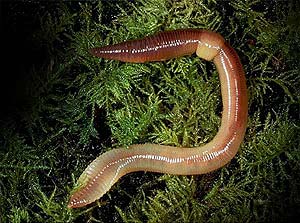
Don’t let the name baffle you; this class is just worms...segmented “super” worms! Annelids are considered a “super-phylum”. We imagine that’s a worm in a cape. However if we do introduce you to one, the first thing you’d probably say is, “Eeew! Get that thing away from me!” They include a group of invertebrates that includes earthworms, rag worms and leeches. There are over 17,000 species of segmented worms alive today. They are found in marine environments from tidal zones to hydrothermal vents, in freshwater, and in moist terrestrial environments. There exists no way we can possibly single them out, based on a single feature, from other invertebrate classes. But they do have a distinct combination of features; i.e. long bodies with segments that are divided on the outside by shallow ring-like constrictions (annuli) and internally by septa (partitions) at the same points, although in some species the septa are incomplete and in a few cases absent. They share a common gut, circulatory system and nervous system that are inter-dependent, although most of the segments contain the same sets of organs. Their bodies have an outer covering called a cuticle that is secreted by cells in the skin underneath. Closed circulatory systems have the blood make an entire circuit via blood vessels.
Some other features are:
Are bilaterally symmetrical and vermiform
They have more than two cell layers, tissues and organs
Body possesses a through gut with mouth and anus
Body possesses 3 separate sections, a prosomium, a trunk and a pygidium
Has no true respiratory organs
Reproduction normally sexual and gonochoristic or hermaphroditic
Feed a wide range of material and can survive in most environments
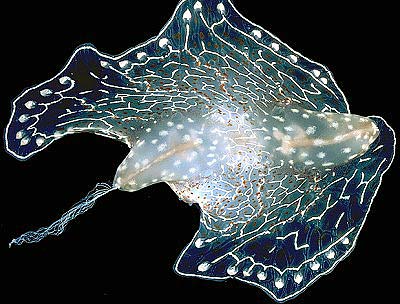
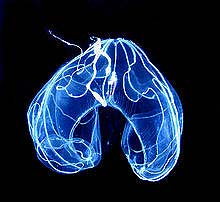
These are a group of animals that live in the abundant marine waters world-wide and are commonly known as comb jellies. Their very similar to phylum cnidarians and most scientists chose to classify them under one phylum. However increasing research has brought out their differences which require them to be classified separately. Their most distinct feature is their “combs” (cilia) which they use for
swimming, making them the largest animals that swim by means of cilia. The mass of jelly that makes up the body of a cnidarians has one layer of cells on the outside and another lining the internal cavity. In ctenophores these layers are two cells deep while those in cnidarians are only one cell deep. All ctenophores are predators and can eat ten times their own weight in a day preying on microscopic larvae, rotifers as well as the adults of small crustaceans; the exceptions are juveniles of two species, which live as parasites.
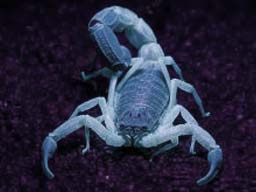
Fear of the dark... you have a constant fear that something’s always near... Well shine an ultra violet light on it already!
....if that “something” is glowing under the light it most probably is a Scorpion. Scientists are not quite sure why scorpions glow florescent under ultraviolet light. They are tough and are able to change their metabolic rate (the amount of energy expended in a given period), to as little as one-third the typical rate for arthropods. They do this when food is scarce and this amazing technique enables some species to live on a single insect per year and use little oxygen. And when food strolls round the corner the scorpion is able to spring quickly to the hunt, low metabolism and all – a gift many hibernating species wish they had. Remarkable survival techniques allow the scorpion to inhabit the world’s toughest environments. This means if you stored a scorpion in a refrigerator overnight he would still be able to thaw out and walk away in to the sun. Of the 2000 scorpion species only 30 or 40 have strong enough poison to kill a person. Different species have a variety of effective, custom-made venom based on the injector’s lifestyle and effectiveness against the species’ chosen prey. Scorpions typically eat insects, but their diet can be extremely variable. Commonly assumed to be desert dwellers, they are also found in Brazilian rainforests, British Columbia, North Carolina, and even the Himalayas. But there’s one thing that appears on the blank “Don’t leave home without it” list of this fascinating animal – Soil! They are burrowing animals, so in areas without loose soil like permafrost or heavy grasses, scorpions may not be able to survive. Yeah we hear you; there had to be something right!
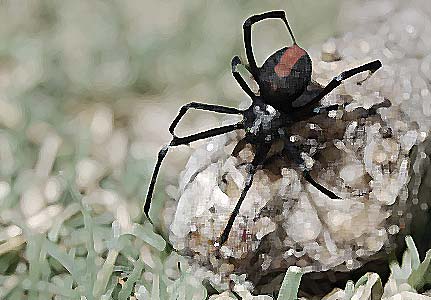
The guy who named this little creature knew his Superheroes well!
The Black Widow Spider is a name derived from “Black Widow” and “Spider-man” two famous Marvel comic characters. Ok, we’re not sure you bought that, but if you did, just letting you know we were goofing around. Black Widow spiders are notorious and branded with a coloured, hourglass-shaped mark on their abdomens and are found in temperate regions across the globe. The bite of this spider is venomous and is said to be about 15 times stronger than the rattlesnake’s. It is not fatal to humans and at most causes nausea, muscle aches and a paralysis of the diaphragm that can make breathing difficult. No serious damage is observed in most people. However the bites can be fatal to young children, the elderly or the infirm but this too is uncommon as the spider is not aggressive and bites only in self-defence. Insects and male black widow are not that lucky though. The females sometimes kill their companion after mating before releasing him. The Black Widows name is in fact the outcome of this gruesome mating ritual. Food preferences include flies, mosquitoes, beetles, caterpillars and grasshoppers which they catch using their web, thereafter covering their prey with silk once it has been trapped. The black widow then punctures its prey with fangs and administers digestive enzymes to the corpses. The enzymes and gnashing fangs proceed to liquefy the prey's bodies which they then go on and suck up.
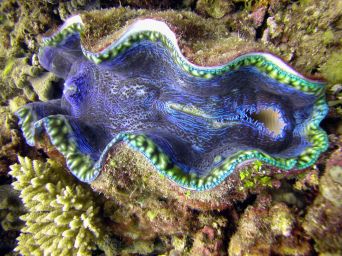
I’ll just wait here!! ....said the Giant Clam
And he had no other option. The Giant Clam gets only one chance to find a nice home. Once it fastens itself to a spot on a reef, there it sits for the rest of its life. It must get pretty boring living life at a standstill. These bottom-dwellers are the largest molluscs on earth, capable of reaching 4 feet in length and weighing more than 227kgs. They can be found in warm waters of the South Pacific and Indian Oceans. They reach their gargantuan sizes feeding on the sugars and proteins produced by billions of algae living in their tissues. It’s a give-and-take relationship here – the algae find a comfy home in the clam, with regular access to sunlight necessary for photosynthesis, with their fluted shells open and their multi-coloured mantles exposed, the giant clam basks in the sunlight by day. They also feed on passing plankton using siphons to draw in water. The adductor muscle of the giant clam is a major ingredient in many scrumptious delicacies. The giant clams have acquired a villainous and highly undeserved reputation of being man-eaters waiting to clamp down on unsuspecting swimmers and swallow them whole. This is very improbable, seeing as the adductor muscle moves way too slowly for the clam to catch a swimmer passing by and the clam would rather retreat into its shell than try sampling humans.
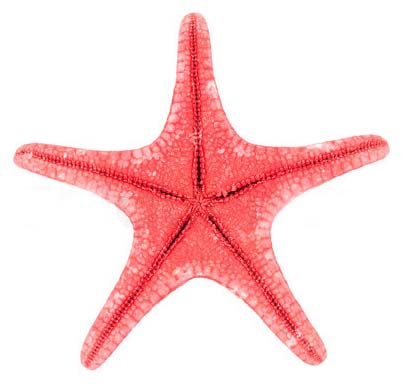
This one’s a real starfish
These stars are Sea Stars!
Many a scientist are trying to replace the name of our dearest Starfish with Sea Star and the reason for this is that the starfish is not a fish but in fact an echinoderm. So we decided to help them out. Moving on, the Sea star can be found be found in oceans (there are no fresh water sea stars) the world over and have around 2000 species known to mankind. The most common of them are the five-pointed arm variety, and incidentally that’s where they get their names. However there are sea stars with as many as 10, 20 or 40 arms. These invertebrates have no brains or blood and make do with filtered sea water for the latter; the former is not so easily substituted. They have bony, calcified skin that helps in keeping predators at bay. Their outstanding colours work as either camouflage or towards scaring off predators. The famed feature of the sea star is its ability to re-grow limbs and sometimes even entire bodies. This is possible because the sea star houses most of its vital organs in its arms. Though some need the central body to be intact in order to carry out the regeneration others can grow a brand new sea star just from a piece of severed limb. Another remarkable feature of the sea star is its ability to feed outside their bodies. They prise open clams or oysters using tiny suction-cupped tube feet and then with the help of the sac-like cardiac stomach, that emerges from their mouth and oozes into the shell, they encase the prey digesting it before withdrawing it back into the body.
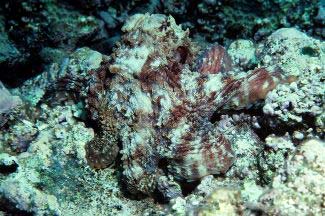
The master of escaping acts – Houdini! ...Or could it be....?
The Common Octopus! Well for starters, handcuffing all eight arms is going to be quite tedious. This fascinating creature is truly the master of disappearing acts among the underwater invertebrates and uses a large collection of techniques to evade or thwart attackers. The most incredible form of defence applied by the common octopus is its ability to hide itself in plain sight. It does this by matching colours, patterns, and even textures of the surroundings; and this modification is instantaneous. How is that possible? Well they do this with a network of pigment cells and specialized muscles in its skin. If its predators only knew...the food they were hunting down was floating right in front of them, they wouldn’t just swim by. The frequently tricked fish include the dolphin, shark and eels. However if ever any of these hunters do look past the trickery, they are doused in a cloud of black ink that obscures their view, giving the octopus time to swim away. The black ink also contains a substance that dulls the predator's sense of smell, making the fleeing octopus harder to track. We bet Houdini wouldn’t be able to perform these next two acts the common octopus is so accomplished at – the ability to squeeze into ridiculously small cracks and crevices where predators can’t follow and the ability to lose an arm in order to escape a predator's grasp and re-grow it later with no permanent damage. It preys on crabs, crayfish, and mollusks, and will sometimes use their ink to disorient their victims before attacking. They also deliver a nasty bite with their beak-like jaws and their venomous saliva helps subdue prey. They are found in tropical and temperate oceans of the world and can grow to about 4.3 feet (1.3 meters) in length and weigh up to 22 pounds (10 kilograms). They are considered the most intelligent of all invertebrates.
G Kowledge of | 3 Comments >>
3 Comments
Regards for this marvellous post, I am glad I detected this website
Magnificent site. Lots of useful info here. I am sending it to a few buddies ans also sharing in delicious. And obviously, thanks on your sweat!
Leave Comment
Your email address will not be published. Required fields are marked.
Do you mind if I link to your motorcycle blog?